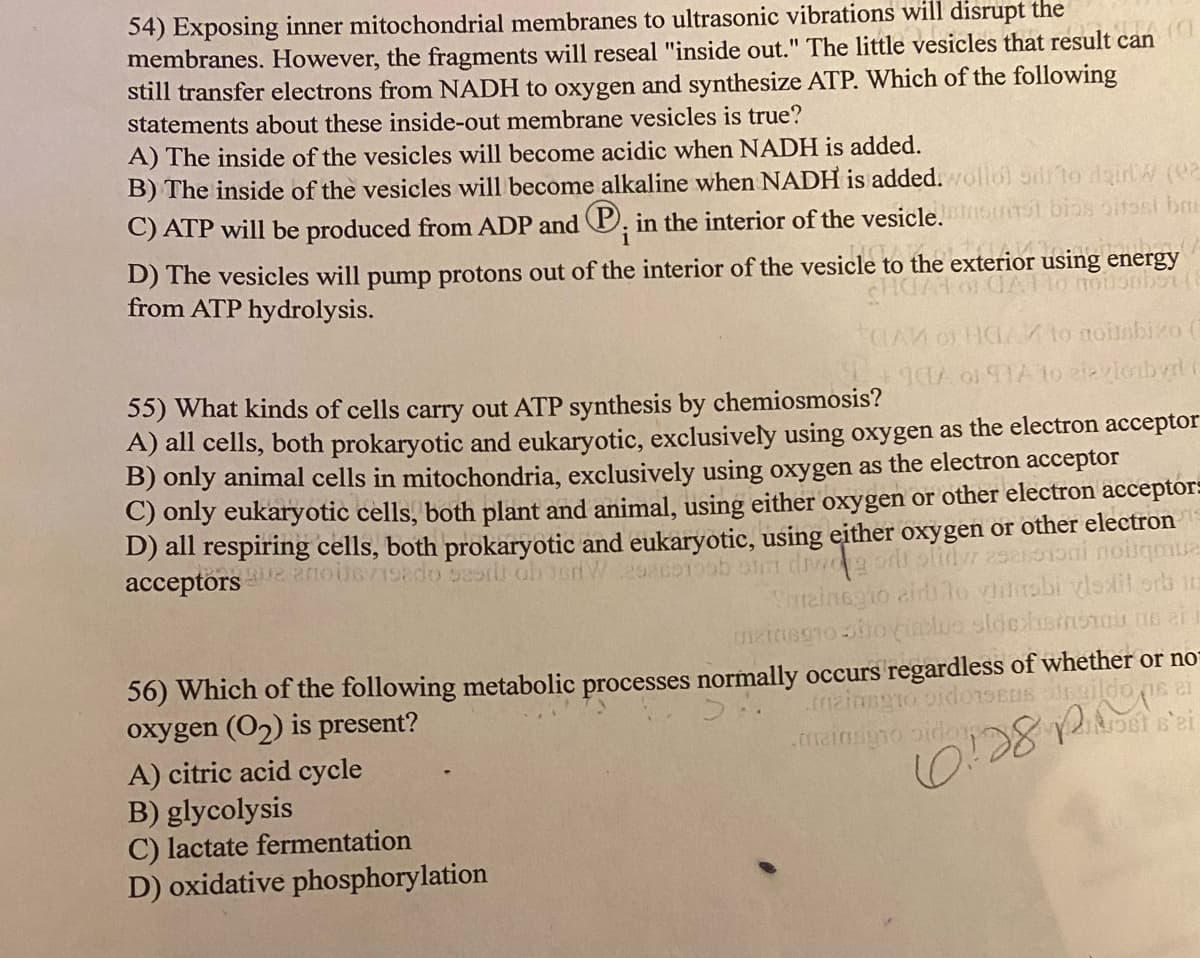54) Exposing inner mitochondrial membr membranes. However, the fragments will reseal "inside out." The little vesicles that result can still transfer electrons from NADH to oxygen and synthesize ATP. Which of the following nes to statements about these inside-out membrane vesicles is true? A) The inside of the vesicles will become acidic when NADH is added. B) The inside of the vesicles will become alkaline when NADH is added. ollol silito dairl W ( C) ATP will be produced from ADP and P, in the interior of the vesicle.snst biaS oitasi i D) The vesicles will pump protons out of the interior of the vesicle to the exterior using energy from ATP hydrolysis. Ro nouonber 55) What kinds of cells carry out ATP synthesis by chemiosmosis? A) all cells, both prokaryotic and eukaryotic, exclusively using oxygen as the electron accept B) only animal cells in mitochondria, exclusively using oxygen as the electron acceptor C) only eukaryotic cells, both plant and animal, using either oxygen or other electron accept- D) all respiring cells, both prokaryotic and eukaryotic, using either oxygen or other electron acceptors 2 noe19ado besrli ob en Sateinegio aidi lo vidrobi vlsxil orb natnsgiosho iacluo slochamorou ne 56) Which of the following metabolic processes normally occurs regardless of whether or oxygen (O2) is present? A) citric acid cycle B) glycolysis C) lactate fermentation D) oxidative phosphorylation
54) Exposing inner mitochondrial membr membranes. However, the fragments will reseal "inside out." The little vesicles that result can still transfer electrons from NADH to oxygen and synthesize ATP. Which of the following nes to statements about these inside-out membrane vesicles is true? A) The inside of the vesicles will become acidic when NADH is added. B) The inside of the vesicles will become alkaline when NADH is added. ollol silito dairl W ( C) ATP will be produced from ADP and P, in the interior of the vesicle.snst biaS oitasi i D) The vesicles will pump protons out of the interior of the vesicle to the exterior using energy from ATP hydrolysis. Ro nouonber 55) What kinds of cells carry out ATP synthesis by chemiosmosis? A) all cells, both prokaryotic and eukaryotic, exclusively using oxygen as the electron accept B) only animal cells in mitochondria, exclusively using oxygen as the electron acceptor C) only eukaryotic cells, both plant and animal, using either oxygen or other electron accept- D) all respiring cells, both prokaryotic and eukaryotic, using either oxygen or other electron acceptors 2 noe19ado besrli ob en Sateinegio aidi lo vidrobi vlsxil orb natnsgiosho iacluo slochamorou ne 56) Which of the following metabolic processes normally occurs regardless of whether or oxygen (O2) is present? A) citric acid cycle B) glycolysis C) lactate fermentation D) oxidative phosphorylation
Biology: The Dynamic Science (MindTap Course List)
4th Edition
ISBN:9781305389892
Author:Peter J. Russell, Paul E. Hertz, Beverly McMillan
Publisher:Peter J. Russell, Paul E. Hertz, Beverly McMillan
Chapter4: Cells
Section: Chapter Questions
Problem 15TYK
Related questions
Question
#54 #55 and #56 need an explanation please

Transcribed Image Text:54) Exposing inner mitochondrial membranes to ultrasonic vibrations will disrupt the
membranes. However, the fragments will reseal "inside out." The little vesicles that result can
still transfer electrons from NADH to oxygen and synthesize ATP. Which of the following
statements about these inside-out membrane vesicles is true?
A) The inside of the vesicles will become acidic when NADH is added.
B) The inside of the vesicles will become alkaline when NADH is added. ollol oilUlo dairl (02
C) ATP will be produced from ADP and P. in the interior of the vesicle.snst bias oirosi bai
i
D) The vesicles will pump protons out of the interior of the vesicle to the exterior using energy
from ATP hydrolysis.
CHCA
55) What kinds of cells carry out ATP synthesis by chemiosmosis?
A) all cells, both prokaryotic and eukaryotic, exclusively using oxygen as the electron acceptor
B) only animal cells in mitochondria, exclusively using oxygen as the electron acceptor
C) only eukaryotic cells, both plant and animal, using either oxygen or other electron acceptor=
D) all respiring cells, both prokaryotic and eukaryotic, using either oxygen or other electron
acceptors oteado estli ob osW98c010ob atm divogod olidw 2520100i noitqmua
Srtainegio aird lo ddirobi vlsil orb in
56) Which of the following metabolic processes normally occurs regardless of whether or no
oxygen (O2) is present?
A) citric acid cycle
B) glycolysis
C) lactate fermentation
D) oxidative phosphorylation
.mainsgiooidonsens iildo ns ai
Expert Solution
This question has been solved!
Explore an expertly crafted, step-by-step solution for a thorough understanding of key concepts.
This is a popular solution!
Trending now
This is a popular solution!
Step by step
Solved in 2 steps

Knowledge Booster
Learn more about
Need a deep-dive on the concept behind this application? Look no further. Learn more about this topic, biology and related others by exploring similar questions and additional content below.Recommended textbooks for you

Biology: The Dynamic Science (MindTap Course List)
Biology
ISBN:
9781305389892
Author:
Peter J. Russell, Paul E. Hertz, Beverly McMillan
Publisher:
Cengage Learning

Human Biology (MindTap Course List)
Biology
ISBN:
9781305112100
Author:
Cecie Starr, Beverly McMillan
Publisher:
Cengage Learning

Biology Today and Tomorrow without Physiology (Mi…
Biology
ISBN:
9781305117396
Author:
Cecie Starr, Christine Evers, Lisa Starr
Publisher:
Cengage Learning

Biology: The Dynamic Science (MindTap Course List)
Biology
ISBN:
9781305389892
Author:
Peter J. Russell, Paul E. Hertz, Beverly McMillan
Publisher:
Cengage Learning

Human Biology (MindTap Course List)
Biology
ISBN:
9781305112100
Author:
Cecie Starr, Beverly McMillan
Publisher:
Cengage Learning

Biology Today and Tomorrow without Physiology (Mi…
Biology
ISBN:
9781305117396
Author:
Cecie Starr, Christine Evers, Lisa Starr
Publisher:
Cengage Learning